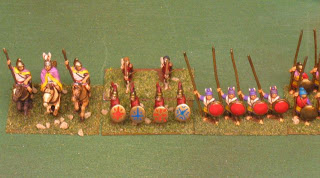 Several years ago, I bought a 15mm Essex Miniatures Alexandrian Macedonian army for DBA. This is the army Alexander the Great used to conquer “the known world.” I wasn’t particularly interested in Alexander the Great, but he was a contemporary enemy of the Later Spartan army I already had. Conquering the known world tends to accumulate enemies, so there would be plenty of options for fighting reasonably historically matched battles with these guys.
Several years ago, I bought a 15mm Essex Miniatures Alexandrian Macedonian army for DBA. This is the army Alexander the Great used to conquer “the known world.” I wasn’t particularly interested in Alexander the Great, but he was a contemporary enemy of the Later Spartan army I already had. Conquering the known world tends to accumulate enemies, so there would be plenty of options for fighting reasonably historically matched battles with these guys.
Except for one thing: no one else actually plays DBA. At the very least I’d need to paint all the armies and bring all the terrain. So when it actually came down to painting the army, I basically finished the two Psiloi elements (two foot bowmen each, on the flanks) and stopped.
Now, years later, I’ve started painting again. I decided to sneak a few of Alexander’s troops in while I was painting my Middenheimers, but then I ran out of Middenheimers to paint, so I just finished these instead.
 Alexander leads the cavalry charge from his right flank. Light troops link the cavalry to the pike block in the center, and prevent them from being encircled.
Alexander leads the cavalry charge from his right flank. Light troops link the cavalry to the pike block in the center, and prevent them from being encircled.
Wargamers tend to be pretty picky people. You can’t paint your American Revolutionary War British troops yellow without being ridiculed, for example. So I spent a lot of time researching what color Alexander’s troops should be painted. But I discovered something interesting: this happened so long ago, no one really knows. In the Ancients period, people don’t seem to be all that picky about getting the uniform colors perfect.
Alexander was a successful conqueror, so many of his documents survived long enough for historians to write about him in the following centuries. We know where he went, how many troops he had, and how they fought. But apparently no one bothered to write down what color the uniforms were. There are a few sources useful to extrapolate uniform colors, but there are only a handful of examples, and their pigments have surely changed color in the last 2300 years.
So, it’s impossible to tell whether all of Alexander’s pikemen were dressed in lavender with yellow stripes, or whether this was reserved for only certain troops, or special occasions. In any case, everyone seems to agree that Alexander’s uniforms were quite ugly.
 The pike block in the center was the backbone of Alexander’s army. It formed the anvil against which the Cavalry’s hammer slammed the enemy.
The pike block in the center was the backbone of Alexander’s army. It formed the anvil against which the Cavalry’s hammer slammed the enemy.
While researching uniforms, I’ve learned a lot more about Alexander the Great’s major battles and overall conquests than I intended. It has been interesting.
 On the left flank, more cavalry prevents the enemy from encircling the pike block in the center.
On the left flank, more cavalry prevents the enemy from encircling the pike block in the center.
Alexander’s recurring major enemy seems to be Darius II, king of the Persian empire. He had huge numbers of troops, and almost always outnumbered Alexander (sometimes by more than a factor of 10). But Alexander always won because of Daruius’ weakness: he was very eager to run away whenever he saw Alexander anywhere near him, and the rest of his troops followed him even when the battle was going well.
This makes it difficult to accurately wargame battles between Alexander and the Persians, without making it seem contrived and broken. “Roll a die to see if Darius runs away this turn” isn’t very fun. DBA sacrifices numerical accuracy for playability: all armies are represented by exactly 12 elements (my army above contains a few different options that I’d choose 12 from before I started a game).
Hopefully I can convince some unsuspecting newcomers to play a game or two of DBA. In the mean time, I’ll start painting another of Alexander’s enemies: the Scythians. Horse archers, anyone?